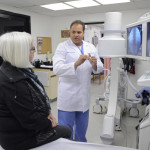What is Migraine?
According to the World Health Organization, severe headaches are top 20 among all disability-causing diseases worldwide. Approximately 45 million Americans suffer from chronic headaches, and of them, about 30 million suffer from migraines. A Migraine is a chronic neurological disorder, a common type of headache that occurs with accompanying symptoms such as intense throbbing or pulsing sensations, nausea, vomiting, and severe sensitivity to sound and light. Migraine victims have been known to experience symptoms for days which prevent them from doing daily activities. Migraines are so severe, that often times victims experience problems with relationships, depression, and even thoughts of suicide.
There are two types of head-pain classifications: primary and secondary headaches.
Primary Headaches Include: migraine, tension, and cluster headaches, as well as several other less common types. Primary headaches usually first start when people are between 20 and 40 years old. Most experts have identified that primary headaches are caused by a combination of vascular and neurological disorders in the head and neck. Genetics and environmental causes also contribute to migraines.
Secondary Headaches: Stem from underlying causes related to structural or functional disorders in the head or neck. Numerous causes that could be responsible for this type of headache range from bleeding in the brain, aneurism, tumors, meningitis and encephalitis.
Causes of Primary and Secondary Headaches:
- Stress
- Hunger
- Fatigue
- Bright lights
- Drinking alcohol
- Loud noises
- Neck and spine pain
- Certain odors or perfumes
- Hormonal changes
- Certain foods
- Vasoconstriction
- Excessive visual input
- Neurologic disorders
- Allergic reactions
- Disrupted sleep patterns
- Exercise
Although conclusive underlining causes of migraines are still a topic of research, all of the above are known common triggers of head-pain.
Symptoms associated with primary and secondary headaches:
- Pulsating pain
- Loss of appetite
- Pain localized to one side of head (hemicranial)
- Numbness, tingling, weakness
- Facial pain (trigeminal neuralgia)
- Sweating
- Chills
- Fatigue
Causes and Symptoms of Migraines:
Genetic factors and environmental surroundings could play a role in causing migraines. Migraine headaches often begin in childhood through early adulthood. The onset of a migraine can be caused by changes in interaction between the brainstem and pain pathways (such as the trigeminal nerve). Chemical imbalances in the brain lead to drops in serotonin (chemical which helps regulate pain). Low levels of serotonin are subsequently overpowered by neuropeptides sent to the outer part of the brain resulting in a headache. Nausea is one of the most common symptoms associated with migraines and it often worsens with activity, often causing patient disability. Migraine headaches may be accompanied by “sinus-like” symptoms such as facial pain or pressure, watery eyes, and nasal congestion. Migraine pain is frequently one-sided but may reside anywhere on the head.
Stages of a Migraine Attack:
The four main stages of a migraine attack are prodrome, aura, headache, and postdrome.
*You may not experience all of the following stages:
Prodrome: Occurs one to two days before an ensuing migraine. Warning signals include:
- Constipation
- Depression
- Diarrhea
- Neck stiffness
- Food cravings
- Hyperactivity
- Irritability
- Repetitive yawning
Aura: An aura is a warning sensation experienced before or during a migraine attack. Auras are usually perceived as visual but can also be sensory, motor, or verbal disturbances. Each aura can build up gradually over a span of several minutes and last for as long as an hour. Auras include:
- Visual phenomena, bright spots, light flashes, seeing shapes
- Loss of vision
- Pins and needles sensations in an arm or leg
- Speech or language problems known as Aphasia
- Weakness of the limbs (hemiplegic migraine)
Attack: The duration of a migraine varies with each case. An untreated migraine attack can span from four hours to as long as three days. The frequency of migraine attacks varies from person to person. Some victims have reported experiencing migraines several times a month.
The following symptoms are experienced during a migraine attack:
- Pain on one side of your head
- Pulsating, throbbing pain
- Sensitivity to light, sounds, and even smells
- Nausea and vomiting
- Blurred vision
- Diarrhea
- Lightheadedness, which sometimes precedes fainting
Postdrome: Occurs after a migraine attack. During this phase, people have been known to experience a range of emotions from physical and emotional drain to feelings of euphoria.
What we treat:
Physicians at KillMigraine treat patients with most types of frequent, severe, and disabling head pain that has not successfully responded to typical conservative treatments. The categories of head pain and headaches treated at KillMigraine include:
- Migraine headaches with or without aura
- Tension headaches
- Cluster headaches
- New Daily Persistent Headaches (NDPH)
- Persistent Headaches
- Intractable Migraines
- Occipital Neuralgia
- Supraorbital Neuralgia
- Chronic Pain Syndromes, including Reflex Sympathetic Dystrophy (RSD) and Complex Regional Pain Syndrome (CRPS)
- Neuropathic Pain of the Head
- Acute Headaches
- Neuralgia
What to do next:
Your next step is to call us at 1-855-4KILLPAIN (454-5572). Our staff will be more than happy to answer your questions, discuss possible treatment options, and schedule your next appointment.
Submit Your Question Online: We also provide timely feedback on questions submitted online if a phone call is not convenient for you. Please see … below.
Attend our free Migraine Seminar:
KillMigraine hosts free migraine seminars throughout the year. The seminars are a great opportunity for our new patients to inquire into and better inform themselves about their condition. As migraine pain management specialists, we know how complex pain conditions and treatments can be and we are aware of the difficult choices a patient faces when considering options. For this reason, our seminars are designed with the patient in mind. We invite you to come learn about our revolutionary procedure in a relaxed setting where you can be better informed to make important healthcare decisions. At KillMigraine’s seminars you can:
- Learn about the procedure
- Talk with a pain management physician
- Ask questions that concern you
- Talk with other migraine sufferers
- Schedule a private consultation
Course of Action:
- Attend Patient Seminar
- Initial Evaluation
- Insurance Pre-Cert
- Trial Stimulator
- Insurance Pre-Cert
- Permanent Stimulator
*If you have already been through a list of treatments and are ready to see the doctor, please contact us at 1-855-4KILLPAIN (454-5572) to schedule an initial evaluation.
Insurance: Certain procedures may require pre-authorization from your insurance carrier to determine whether the treatment(s) are medically necessary. Your insurance carrier will determine your level of benefits based on your policy and medical history. The pre-authorization process can take a couple of weeks and requires:
- Examination of your medical history
- History of pain treatments to date
- Psychological evaluation
KillMigraine’s mission is to relieve you of migraine pain as soon as possible by making every effort on our part to provide insurance support at your convenience.


